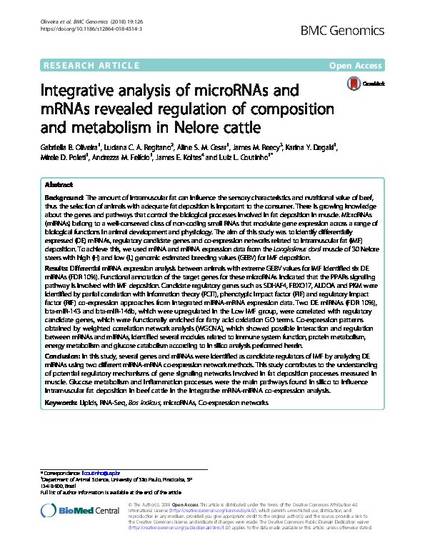
Background: The amount of intramuscular fat can influence the sensory characteristics and nutritional value of beef, thus the selection of animals with adequate fat deposition is important to the consumer. There is growing knowledge about the genes and pathways that control the biological processes involved in fat deposition in muscle. MicroRNAs (miRNAs) belong to a well-conserved class of non-coding small RNAs that modulate gene expression across a range of biological functions in animal development and physiology. The aim of this study was to identify differentially expressed (DE) miRNAs, regulatory candidate genes and co-expression networks related to intramuscular fat (IMF) deposition. To achieve this, we used mRNA and miRNA expression data from the Longissimus dorsi muscle of 30 Nelore steers with high (H) and low (L) genomic estimated breeding values (GEBV) for IMF deposition.
Results: Differential miRNA expression analysis between animals with extreme GEBV values for IMF identified six DE miRNAs (FDR 10%). Functional annotation of the target genes for these microRNAs indicated that the PPARs signaling pathway is involved with IMF deposition. Candidate regulatory genes such as SDHAF4, FBXO17, ALDOA and PKM were identified by partial correlation with information theory (PCIT), phenotypic impact factor (PIF) and regulatory impact factor (RIF) co-expression approaches from integrated miRNA-mRNA expression data. Two DE miRNAs (FDR 10%), bta-miR-143 and bta-miR-146b, which were upregulated in the Low IMF group, were correlated with regulatory candidate genes, which were functionally enriched for fatty acid oxidation GO terms. Co-expression patterns obtained by weighted correlation network analysis (WGCNA), which showed possible interaction and regulation between mRNAs and miRNAs, identified several modules related to immune system function, protein metabolism, energy metabolism and glucose catabolism according to in silico analysis performed herein.
Conclusion: In this study, several genes and miRNAs were identified as candidate regulators of IMF by analyzing DE miRNAs using two different miRNA-mRNA co-expression network methods. This study contributes to the understanding of potential regulatory mechanisms of gene signaling networks involved in fat deposition processes measured in muscle. Glucose metabolism and inflammation processes were the main pathways found in silico to influence intramuscular fat deposition in beef cattle in the integrative mRNA-miRNA co-expression analysis.
Available at: http://works.bepress.com/james_reecy/131/

This article is published as Oliveira, Gabriella B., Luciana CA Regitano, Aline SM Cesar, James M. Reecy, Karina Y. Degaki, Mirele D. Poleti, Andrezza M. Felício, James E. Koltes, and Luiz L. Coutinho. "Integrative analysis of microRNAs and mRNAs revealed regulation of composition and metabolism in Nelore cattle." BMC genomics 19 (2018): 126. doi: 10.1186/s12864-018-4514-3.